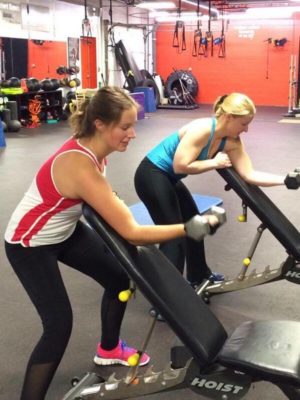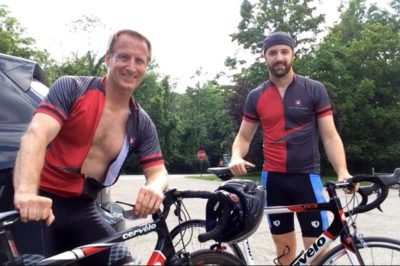Number 9 in a countdown: Fitness counts in racing, but the way you get there is different than most other sports.

While there are certainly still doubters in the world, the idea that racing drivers are athletes is gaining acceptance; for those reading this, there are likely no deniers of that fact. Although the combination of skills, strength and endurance are certainly different than other sports – just like the set of attributes to be successful in football or triathlon are different – there is clearly an advantage to being fit. And that is one of the top 10 things that a racing driver must do to be successful.
However, while fitness is important, the fact that racing does use your muscles in a different way than other sports means some alternate training methods. Training racing drivers is Jim Leo’s specialty. His PitFit Training has trained or helped train a huge number of racing drivers. And he explains that the reasons for being fit go beyond performance.
“There are multiple things to consider when you look at the sport of auto racing,” he says. “There’s the performance aspect; there’s also injury prevention and safety factors in there as well. Just like any athlete, you want to go in and prepare the athlete for the sport they’re participating in to the point they can improve their performance based on physical preparation. But you also want to prepare them for the injury or accident that may occur. Research has shown that the more fit an individual is, the more apt they are to recover faster. In our case, we prepare our athletes in some capacities to reduce the risk of concussion and neck injuries, so it’s really a twofold component.”
That’s an important consideration for racers who may think that because their races only last 30 to 45 minutes, endurance isn’t really a factor. There’s also the matter of the more fit a driver is, the greater concentration he or she will have at the end of the race. Toward that end, most drivers work on cardiovascular fitness. But the means they choose toward that goal may not be the best one.

“A lot of drivers are heavily into cycling or really into running. We really prefer our drivers get into activities that stimulate the upper body much more than running and cycling. Rowing is a good one. Swimming is good. Again, you’re developing upper-body muscular endurance that you need in the race car. We’re a big fan of boxing – it works on reactions, upper body movement and it’s great cardiovascular training,” Leo explains.
The upper body, and the legs, are the areas that seem to get the most work and, dynamically, that’s true. However, there’s an area that many racing drivers don’t consider because it doesn’t move when one is strapped into a racing seat with a seven-point harness – the core – and it’s an important area to work on.
“In most sports, the area of the core is really moving, in a rotational manner, or forward or backward. There’s constant movement – the whole body is really working in most sports. Racing is different in that you are secured tightly to the car, so there really isn’t much movement except the areas of the body that are turning the car or braking or accelerating. The core is kind of stabilized and held in place. When you go into that high-speed corner multiple times during a race, much of the g-forces you encounter are going to be absorbed in that core region, from the hips all the way up. If you don’t have adequate core strength, even though you’re strapped securely into the car, you’ll have some weakness. That can place much more workload on the extremities, the areas of the body that are actually controlling the car,” he says.
He adds that the lower back takes a lot of stress in the car, so from strictly a longevity standpoint, it makes sense to strengthen the core to help protect the lower back.
Joel Miller, driver of the No. 07 Mazda SKYACTIV Diesel Prototype in the TUDOR United SportsCar Championship, agrees that a driver needs to work on the core: “In my personal opinion core strength is very important. I try to do a couple of training routines that incorporate stability/balance into the motion of the exercise when possible.”
Most drivers don’t have the opportunity to train with PitFit in Indianapolis. So Leo has some suggestions for exercises a driver may want to discuss with his or her trainer and introduce into the fitness routine.
• For core stability, try what Leo calls a suitcase carry. It’s carrying a very heavy weight with one hand and walking while keeping your body upright. That works not only on core stability, but grip strength as well.
• Kettlebells are a great tool. Kettlebell swings are one of Leo’s favorites. “A lot of stuff we do is fairly unique, so building muscular endurance in the upper body is fairly important.”
• Battle Ropes – the big heavy ropes that are secured at one end and moved either together or alternating, creating a wave pattern. Leo will even have drivers using them on an Indo Board balance trainer, which is even more challenging. Either way, the core is must remain very stable while you have muscle activations similar to what you would in the racecar.
• Neck training. That can be manual neck resistance with your hand or machines. The neck takes a lot of stress in a race car, especially anything with downforce and higher cornering loads. So the neck must be trained laterally, but also in anterior/posterior movement and rotation.
• Squats, whether with body weight only or with a barbell. Leo says it’s a great fundamental movement to develop hip strength and low back strength that a driver needs.
A final area to work on is hand-eye coordination and reaction training, Leo says. However, that can be more specialized and many personal trainers aren’t equipped or knowledgeable about the required exercises. There is, however, a variety of information on the topic available. Look for some more information on the subject here in the near future.
For more information on Leo and PitFit Training, see www.pitfit.com. PitFit also puts many exercise videos and tips on its Facebook page.
Related Content:
Be the Complete Racer: Choices

 ACCESSIBILITY
ACCESSIBILITY